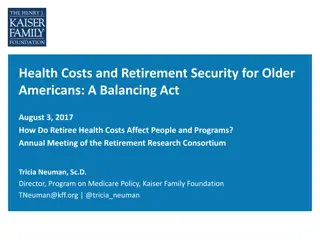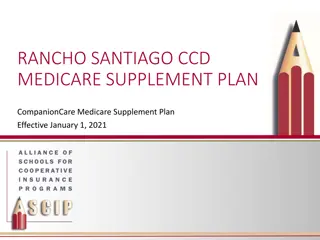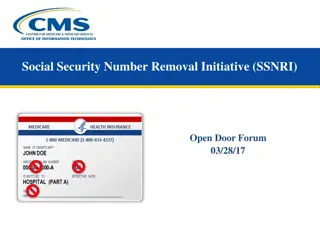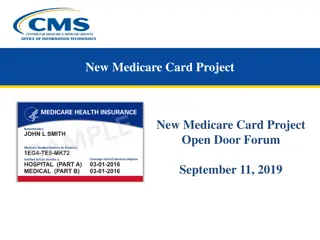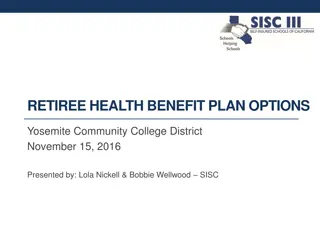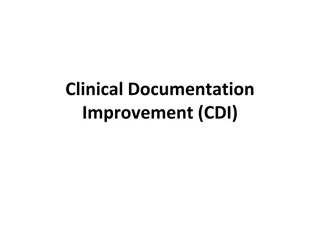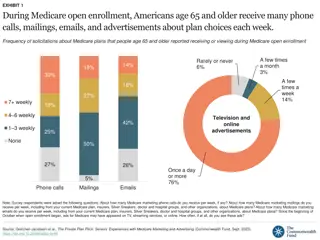Understanding Medicare and Retiree Health Benefits
Explore details about Medicare, retiree health benefits, enrollment periods, and available health plans for retirees. Learn about eligibility criteria, coverage options, and enrollment processes to make informed decisions for your retirement healthcare needs.
Download Presentation

Please find below an Image/Link to download the presentation.
The content on the website is provided AS IS for your information and personal use only. It may not be sold, licensed, or shared on other websites without obtaining consent from the author. Download presentation by click this link. If you encounter any issues during the download, it is possible that the publisher has removed the file from their server.
E N D
Presentation Transcript
Objective: Answer These Questions What about Medicare? Which health & welfare benefits can continue into retirement? Who is eligible for retiree health? How much will you have to pay? What Health Plans are available to me in retirement? 2
Medicare 3
Medicare Health insurance for: People at age 65; People disabled for 24 months on approved Social Security disability; People with End Stage Renal Disease (ESRD); People with Amyotrophic Lateral Sclerosis (ALS) Four Parts of Medicare insurance (A, B, C, D) Part A = hospital Part B = medical doctor visits Part C = A, B, and sometimes D (Medicare Advantage Plan) Part D = prescription drug coverage (Rx) Coverage regardless of pre-existing conditions or level of income Health Net Seniority Plus & Kaiser Permanente Senior Advantage = Medicare Advantage plans with A, B, D assigned over to the plan Anthem Blue Cross Retiree Medicare plans = Medical plans that work as secondary to Medicare Parts A & B, have Part D benefits through the plan 4
When can someone enroll in Medicare? Initial Enrollment Period (IEP) when first eligible for Medicare Special Enrollment Period (SEP) when covered by and leaving an employer group health plan General Enrollment Period (GEP) occurs each year for those who have missed IEP or SEP 5
Initial Enrollment Period (IEP) Eligibility at age 65; after 24 months approved Social Security disability; End Stage Renal Disease (ESRD), Amyotrophic Lateral Sclerosis (ALS) Federal Insurance Contributions Act (FICA) paid 40 quarters Receiving Social Security, Railroad Retirement Board (RRB) benefits, or Civil Service benefits Enrollment Timing Part A and Part B 7 month period (starts 3 months before 65); Part D 2 month period Enrollment Process Part A and Part B automatic if receiving retirement income Medicare Card sent to enrollee (red, white, & blue card) To delay automatic enrollment return card and follow instructions with card 6
Special Enrollment Period (SEP) Eligibility People who delayed IEP enrollment can enroll Enrollment Timing Part B 8 month period that starts 1st day of month after employment or coverage ends, whichever occurs earlier; Part D 2 month period after employment or coverage ends, whichever occurs earlier Enrollment Process not automatic With large Employer Group Health Plan (EGHP) can delay no penalty Domestic Partners - Usually not eligible for SEP; late enrollment penalty may apply if don t enroll at age 65; advised to contact Social Security 3 months before age 65 7
General Enrollment Period (GEP) Eligibility Anyone eligible who did not enroll during IEP or SEP Enrollment Timing January 1 March 31; coverage starts July 1 of that year Enrollment Process not automatic Late-enrollment penalty; normally pay penalty as long as covered Part A none, UC requires only if premium-free Part B 10% for each 12 months eligible, not enrolled Part D 1% for each 12 months eligible, not enrolled Most UC employees and retirees do not enroll during GEP Most UC employees enroll in Part A during IEP Most UC retirees enroll in Part B and Part D during SEP; or during IEP if they turn 65 after retirement 8
How are Medicare premiums paid Automatically withheld from Social Security income Direct payment to Social Security Administration Quarterly (3 month bill) Medicare Easy Pay Deduct monthly Medicare premium from Banking Account 9
Costs of Medicare Part B Premiums (2019) Beneficiaries who file individual tax returns with income Beneficiaries who file joint tax returns with income: Income-related monthly adjustment amount Total monthly premium amount Less than or equal to $85,000 Less than or equal to $170,000 $0.00 $135.50 Greater than $85,000 and less than or equal to $107,000 Greater than $170,000 and less than or equal to $214,000 $54.10 $189.60 Greater than $107,000 and less than or equal to $133,500 Greater than $214,000 and less than or equal to $267,000 $135.40 $270.90 Greater than $133,500 and less than or equal to $160,000 Greater than $267,000 and less than or equal to $320,000 $216.70 $352.20 Greater than $160,000 and less than $500,000 Greater than $320,000 and less than $750,000 $297.90 $433.40 Greater than or equal to $500,000 Greater than or equal to $750,000 $325.00 $460.50 10
Health & Welfare Benefits Retirees may continue into retirement: Medical, Dental, and Legal Vision: VSP: Retiree can pay full premium to VSP Frame allowance: $150 ($20 more vs. employee VSP) $55 copayment for progressive lenses Health Net & Kaiser cover eye glasses for members with Medicare Health Insurance After You Retire 12
Eligibility for Retiree Health Medical & Dental insurance may continue into retirement: UC Retirement Plan (UCRP) members must elect monthly retirement income Must retire within 120 days of terminating UC employment Insurance coverage must be continuous If you elect a lump sum cashout, you forfeit UC health insurance 13
When a UC employee retires Special Enrollment Period (SEP) Eligible to enroll in Medicare at separation Part A is premium-free Medicare not required, if not eligible for premium-free Part A Retirement counseling Request for Employment Information (CMS L564) form 2-3 months prior to separation - employee begins Medicare enroll process 14
UCs Medicare Requirements Retirees (not employees) and their family members must enroll in Medicare Part B: If they are enrolled in medical insurance If they are eligible for Part A free of charge You can be eligible for Part A for free through a current or former spouse, even if you didn t pay in to Social Security 15
Compliance with UC Policy Retirees and family members must enroll in Part B if they are eligible for premium- free Part A Must maintain Part B coverage by paying premiums to Social Security Must assign benefits to Medicare complete Blue Shield of California Part D form or UBEN127 Consequences for non-compliance 16
Health Savings Plan (HSP) and Medicare If a UC employee or family member is already in Medicare, he or she should not enroll in UC s HSP. If a UC employee or family member is currently enrolled in UC s HSP and during the year enrolls in Medicare (A, B, C, or D), he or she must end his or her HSP coverage and stop contributing to the HSP effective the month Medicare coverage begins. The member can continue to use the HSA funds for eligible expenses. Important Note: Since UC will not know about Medicare enrollment, UC relies on the person to confirm that he or she is eligible for the HSP. It is the person's responsibility to ensure he or she meets the HSA eligibility requirements. 17
When did you join UCRP? Before 1/1/1990: Ages 50-54: Must have 10 years of service credit Age 55+: Must have 5 years of service credit Must not have had a break in service of more than 120 days Eligible for 100% of UC s maximum contribution toward medical and dental insurance On or after 1/1/1990: Graduated Eligibility On or after 7/1/2013: Come back and see me in 20 years 18
Graduated Eligibility Percentage of UC s maximum contribution based on full years of UCRP service credit UCRP Entry Date: 1/1/1990 6/30/2013 Service Credit Percentage of UC s contribution 0-4 N/A If Age + Service Credit 75: 50% 5-9 (otherwise not eligible) 10 50% 55-100% 11-20 (5% for every year above 10) 19
Example A (2019) Employee with 20 years of UCRP service credit retires with UC Blue & Gold (non-Medicare) Total premium: $755.70/month Max UC contribution: $522.37 Net cost to retiree: $233.33 20
Example B (2019) Employee with 10 years of UCRP service credit retires with UC Blue & Gold (non-Medicare) Total premium: $755.70/month UC contribution: $261.19(50% of $522.37 = $261.19) Net cost to retiree: $494.51 ($755.70 - $261.19) 21
Part B Reimbursement If the maximum UC retiree health contribution (after any reduction for graduated eligibility, if applicable) is greater than the rate for the Medicare-coordinated plan selected, then the difference is used to reimburse the retiree for all or a portion of the standard Medicare Part B premium. Amount can change each year; normally doesn t apply for people with Graduated Eligibility 22
Example C (2019) Employee with 20 years of UCRP service credit retires with Medicare and Health Net Seniority Plus Total Premium: $428.07/month Max UC contribution: $360.66 Health Net premium paid by retiree: $67.41 ($428.07 - $360.66) Part B premium: $135.50 Net cost to retiree: $202.91 ($134.00 + $76.66) 23
Example D (2019) Employee with 20 years of UCRP service credit retires with Medicare and Kaiser Permanente Senior Advantage Total Premium: $275.00/month Max UC contribution: $360.66 Part B premium: $135.50 Part B reimbursement: $85.66 ($360.66 - $275.00) Net cost to retiree: $49.84 ($135.50 - $85.66) 24
Medicare Part D Outpatient prescription drug benefit Subsidizes medical plan premiums The Rx coverage of UC medical plans is equivalent to or better than Part D Considered creditable coverage You may be asked about past Rx coverage Formulary may differ from non- Medicare plan 25
More on Part D Retirees with Medicare must complete a form No additional Part D premium Exception: high income enrollees Complicates or prevents double coverage Enrollment in another Part D plan may result in loss of UC coverage 26
Part D - Low Income Subsidy Retirees apply through Social Security Administration or their State Medicaid agency Once application is approved by CMS an award letter is sent to member and copy to medical plan carrier Plan carriers send monthly and quarterly reports to UC listing beneficiaries and refund amounts UC will issue a refund check up to the amount of the premium. If the premium is less than the refund, UC will only refund up to the amount of the premium. For example, if CMS approves a refund of $50.00 but the member s contribution toward UC medical plan coverage is $40.00, UC will issue a refund check for $40.00. If the premium is $0.00, nothing is paid to the member. 27
Changing Retiree Health Plans Open Enrollment Period of Initial Eligibility Move outside HMO service area for 2+ months Involuntary loss of other coverage Addition of newly eligible family members Can suspend medical/dental coverage 28
About Retiree Health Plans
Medicare & HMOs Medicare Advantage plans If you have Medicare A & B, and you are enrolled in an HMO, you must assign your Medicare benefits to the HMO (by form) Medicare pays a flat monthly fee to the insurance company Medicare cannot be used separately from the Medicare Advantage plan 30
Medicare Advantage Plans HMO UC Blue and Gold HMO Seniority Plus Kaiser Permanente Medicare Senior Advantage 31
HMO coverage: Copayments Physician office visit: $20 ER: $75 (Medicare: $65) Emergencies covered worldwide Outpatient surgery: $100 Inpatient hospitalization: $250 Behavioral health outpatient: $20 Behavioral health inpatient: $250 32
HMO behavioral health Medical Plan Behavioral Health Plan Kaiser Permanente Go through PCP and/or Optum Kaiser Permanente Senior Advantage Go through PCP Health Net Seniority Plus MHN: Managed Health Network New for 2019: MHN (Managed Health Network) UC Blue & Gold HMO (Health Net) 33
Non-Medicare HMO Rx Kaiser Permanent e Rx 30-day supplies UC Blue & Gold HMO WHA Tier 1 (generic, formulary) Tier 2 (brand name, formulary) Tier 3 (non-formulary) Some meds require prior authorization $5 $5 $5 $25 $25 $25 $40 N/A $40 34
HMO copayment maximums Out-of-pocket maximum Includes medical, mental health, Rx UC Blue & Gold HMO Kaiser WHA Permanente* $1,000/perso n $1,500/perso n $1,000/perso n $3,000/family $3,000/family $3,000/family * Kaiser maximum does not include Optum copayments 35
HMO Rx: Medicare Part D Rx 30-day supplies Health Net Seniority Plus Kaiser Senior Advantage Tier 1 (generic, formulary) $5 $5 Tier 2 (brand name, formulary) Tier 3 (non-formulary) $25 $25 $40 N/A Rx Out-of-Pocket Max $2,000 $5,100 36
HMO Rx: Part D 90-day supplies Retail pharmacies: 3 copayments UC pharmacies: 2 copayments Does not apply to Kaiser Mail order: 2 copayments Kaiser: 100-day supplies 37
Medicare HMO copay limits Out-of-pocket maximum* Includes medical & mental health Health Net Seniority Plus Kaiser Permanente Senior Advantage $1,500/person $1,500/person $3,000/family * Maximums do not include Rx copayments 38
Kaiser Permanente Senior Advantage Kaiser Foundation Health Plan contracts with one large group, the Permanente Medical Group Available in most of urban California Advanced electronic medical records, online tools, My Health Manager mobile app Clinics tend to offer pharmacies, imaging, laboratories, urgent care all at one location 39
Kaiser Permanente Senior Advantage Classes, pamphlets, videos on a wide variety of health topics Disease Management programs Rx: 30-/60-/100-day supplies at 1x/2x/3x copays Must use Kaiser pharmacies Mail order: 100-day supply for 2x copays 40
Kaiser Permanente vs. Senior Advantage Senior Advantage Kaiser Permanente $1,500 out of pocket limit includes Rx Hearing aids: $1,000 allowance per aid per ear, every 36 months Allergy shots: $5 + Optum behavioral health Acupuncture/chiropractic 24 visit limit (American Specialty network) Rx out of pocket limit: $5,100 Hearing aids: $2,500 allowance per aid per ear, every 36 months $150 allowance for eye glass frames and lenses every 24 months No American Specialty acupuncture Allergy shots: $3 41
Seniority Plus Large provider network Available in most of urban California Decision Power: Track your health issues/knowledge base Health coach (nurse, respiratory therapist, dietitian) 24-hour nurse line, case managers, healthy discounts 42
Seniority Plus Disease Management programs Omada Health weight loss and management program (for those with diabetes and heart risks) Quit for Life program: Smoking cessation phone based behavioral coaching Telemedicine consults 24/7 through Teladoc No copay virtual urgent care visit; less than 1 hour wait 43
Seniority Plus Hearing aids: 2 aids every 36 months; $2,000 benefit max Allergy shots: $20 Pharmacy Benefit Manager: CVS/Caremark Be sure to specify a PCP when choosing either plan 44
UC Blue & Gold HMO vs. Seniority Plus UC Blue & Gold HMO Does offer UCI Physicians and Surgeons $75 ER copay $1,000 per person out of pocket limit for medical, mental health and Rx Health Net Seniority Plus Does NOT offer UCI Physicians and Surgeons $65 ER copay $1,500 per person out of pocket limit for medical & mental health $2,000 Rx OOP limit 45
UC Blue & Gold HMO vs. Seniority Plus UC Blue & Gold HMO 90-day supplies @ local CVS pharmacies Acupuncture/chiroprac tic 24 visit limit (American Specialty network) Mental health (new): MHN Health Net Seniority Plus No acupuncture Eye glasses: $100 frame allowance; lenses covered in full; every 24 months Silver & Fit fitness clubs Mental health: MHN 46
About UC Medicare PPO Medicare pays first for covered services Anthem Blue Cross pays second You pay the balance ~4% if covered by Medicare (20% of the 20% Medicare didn t pay) 20% after $100 deductible if not covered by Medicare New for 2019: LiveHealth Online: $20 48
UC Medicare PPO coverage Medicare-covered services 1. Deductible N/A 2. 4% (20% of the 20% balance left after Medicare pays first) 3. $1,500 out-of-pocket limit Per person, per year Services not covered by Medicare 1. $100 deductible Per person, per year 2. 20% coinsurance 3. $1,500 out-of-pocket limit Per person, per year 49
UC Medicare PPO coverage Medicare primary, Medicare PPO secondary Caution: must use Medicare providers (exception: mental health providers) unless not covered by Medicare Deductible only applies if not covered by Medicare (but covered by plan) Not covered by Medicare* $100 Examples: * Acupuncture * Hearing aids * MFTs * Services outside U.S.A. Self only coverage 1: Deductible 2: Coinsurance 20% 3: Out-of-Pocket Limit $1,500 50



